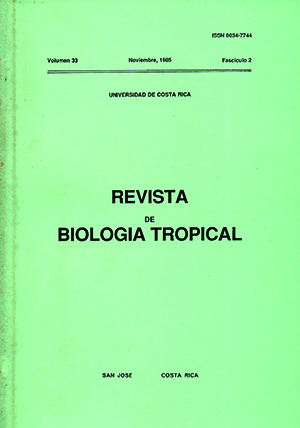Abstract
Coral reefs have a rather limited distribution along the Eastern Tropical Pacific. The reefs found in Costa Rican Pacific waters are small and contain at the mast a dozen coral species. Although coral communities are widespread along the Pacific coast of Costa Rica, reefs in different stages of development are confined to Golfo Dulce, Isla del Caño and Isla del Coco. The coral communities are characterized by isolated corals of the following genera: Pocillopora, Porites and Psamororo. The reefs of Golfo Dulce are dominated by Porites lobata, whilst those of Isla del Caño and Isla del Coco are typified by Pocillopora spp. in shallow waters and by Porites lobata in deeper areas. Costa Rican coral reefs show clear signs of environmental impact due to natural and human induced pressures. Stress of natural originan is related to temperature changes, basically the effects derived from cold upwelled waters and from warm waters such as those associated to El Niño 1982-83. Human induced impact is due mainly to increasing loads of terrigenous sediments and to the extraction of corals. Corrective measures are in order to reduce siltation by stopping deforestation of watersheds, improving agricultural practices and by prohibiting all coral extraction.
References
Bakus, G.J. 1975. Marine zonation and ecology of Cocos lsland, off Central America. Aton Res. Bull., 179, 1-9.
Birkeland, C., D.L. Meyer, J.P. Stames, & C.L. Duford, 1975. Subtidal communities of Malpelo Island. p. 56-58. In J.B. Graham (ed.). The Biological lnvestigation of Malpelo Island, Colombia Smithsonian Contrib. Zool., 176.
Cortés, J. 1986. Biogeografía de corales hermatípicos: El Istmo Centro Americano. Anales Inst. Cien. Mar. Limn. UNAM, (en prensa).
Cortés, J. & M.J. Risk, 1984. El arrecife coralino del Parque Nacional Cahuita, Costa Rica. Rev. Biol. Trop., 32, 109-1 21.
Cortés, J., & M.J. Risk, 1985. A reef under siltation stress: Cahuita, Costa Rica. Bull. Mar. Sci., 36: 339-356.
Cortés, J., M.M. Murillo, H. Guzmán, & J. Acuña. 1984. Pérdida de zooxantelas y muerte de corales y otros organismos arrecifales en el Caribe y Pacífico de Costa Rica. Rev. Biol. Trop., 32: 227-231.
Connen, J.H. 1978. Diversity in tropical rain forest and coral reefs. Science, 199: 1302-1310.
Dana, T.F. 1975. Development of contemporary eastern Pacific coral reefs. Mar. Biol., 33: 355-374.
Dubois, R., & M. Hatziolos, 1982. Inventario de Recursos Marinos. Centro Científico Tropical, (ed.). El Parque Nacional "Manuel Antonio", inventario Biológico Terrestre y Marino. Informe Final de Consultoría para la Dirección de Parques Nacionales, MAG. Mecanografiado.
Durham, J.W. 1966. Coelenterates, especially stony corals from the Galápagos and Cocos Islands, p. 123-135. R.I. Bowman (ed). The Galápagos. University of California Press, Berkeley.
Durham, J.W., & J.L. Barnard. 1952. Stony corals of the Eastern Pacific collected by the Velero III and Velero IV. AlIan Hancock Pacific Expeditions, 16, 1-110.
Glynn, P.W. 1974. The impact of Acanthaster on corals and coral reefs in the Eastern Pacific. Environ. Conserv., 1: 295-304.
Glynn. P.W. 1976. Some physical and biological determinants of coral community structure in the eastern Pacifico Ecol. Monogr., 46: 431-456.
Glynn, P.W. 1977. Coralgrowth in upwelling and nonupwelling areas off the Pacific coast of Panamá. J. Mar. Res., 35:567-585.
GIynn, P.W. 1982. Coral communities and their modifications relative to past and prospective Central American seaways. Adv. Mar. Biol., 19: 91-132.
GIynn, P.W. 1983. Extensive "bleaching" and death of reef corals in the Pacific coast of Panama. Envir. Conserv. 10: 149-154.
Glynn, P.W. 1984. Widespread coral mortality and the 1982/1983 El Niño warming evento Environ. Conserv., 11: 133-146.
Glynn, P.W., & I.G. Maclntyre. 1977. Growth rate and age of coral reefs on the Pacific coast of Panamá. Proc. 3d Int. Coral Reef Symp., Miami, 2: 251-259.
Glynn, P.W., & R.H. Stewart, 1973. Distribution of coral reefs in the Pearl Islands, in relation to thermal conditions. Limnol. Oceanogr., 18: 367-379.
Glynn, P.W., & G.M. Wellmgton. 1983. Corals and coral reefs of the Galápagos Islands. University of California Press. Berkeley, 330 p.
Glynn, P.W., R.H. Stewart, & J.E. McCosker. 1972. Pacific coral reefs of Panamá: structure, distribution, and predators. Geol. Rundschau, 61: 483-519.
Glynn, P.W., G.M. Wellington, & c. Birkeland. 1979. Coral reef growth in the Galápagos: limitation by sea urchins. Science, 203: 47-49.
Glynn, P.W., H. von Prahl, & F. Guhl. 1982. Coral reef of Gorgona Island, Colombia, with special reference to corallivores and their influence on community structure and reef development. An. Inst. lnv. Mar. Punta de Betín, 12: 185-214.
Glynn, P.W., E.M. Druffel, & R.B. Dunbar. 1983. A dead Central American coral-reef tract: possible link with the little Ice Age. J. Mar. Res., 41: 605-637.
Porter, J.W. 1972. Ecology and species diversity of coral reefs on opposite sides of the Isthmus of Panamá, p. 89-1 16. In: M.L. Jones (ed.). The Panamic Biota. Bull. Biol. Soc. Wash., No. 2.
Porter, J.W. 1974. Community structure of coral reefs on opposite sides of the Isthmus of Panamá. Science, 186: 543-545.
Prahl, H., von, F. Guhl. & M. Grogl. 1979. Corgona. Futura Grupo Editorial Ltda., Bogotá, Colombia. 279 p.
Stehli, F.G., & J.W. Wells. 1971. Diversity and age patterns in hermatypic corals. Syst. Zool., 20: 115-126.
Stoddart, D.R. 1969. Ecology and morphology of recent coral reefs. Biol. Rev., 44: 433-498.
Wellington. G.M. 1982. Depth zonation of corals in the Gulf of Panamá: control and facilitation by resident reef fishes. Ecol. Monogr., 52: 22 3-241.
Wells, J.W. 1956. Scleractinia, p. 328.444. In Treatise on Invertebrate Paleontology. Part F. Coelenterata. R.C. Abare (ed.). Geol. Soc. Am. & Univ. Kansas Press.
Comments

This work is licensed under a Creative Commons Attribution 4.0 International License.
Copyright (c) 1985 Revista de Biología Tropical


